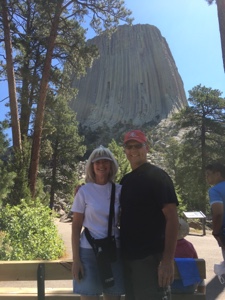If you've seen the 1977 movie, Close Encounters of the Third Kind, then you've seen Devil's Tower National Monument where much of the movie was filmed. Richard Dreyfess, the movie's leading character, is a blue collar worker in Indiana, who becomes obsessed with UFOs after a close encounter with one. Subsequently, he is troubled by mental images of a unique-looking mountain, Devil's Tower. He becomes convinced that alien beings will land at Devil's Tower. What happens next, I'll leave to your imagination.
Fantasy and reality merged for Tim and I when, for the past two nights, we stayed just outside the gates of Devil's Tower at the KOA campground, the purported location of the landing pad used by the aliens' mothership in the movie.
Capitalizing on the movie's cache, the campground's management hosts showings of the movie every night at 8 p.m. With Devil's Tower towering over us, we set up our lawn chairs with the other families staying at the camp, suspended all belief, and settled back to be transported into this science fiction story.
Periodically, I found my eyes drawn upward to the night sky, searching for any UFOs. I wasn't the only one to do so; I noticed many of the kids were looking skyward, too. I hope none had nightmares that night.
Earlier in the day, we caught the two-hour guided hike with Erin, a seasonal ranger at the park. She told us how molten magma was forced into the sedimentary rocks above it where it cooled, contracted and fractured into columns. Over time, the sediment eroded, leaving Devil's Tower exposed.
"The Tower," she said, "is a sacred site to the six Native American tribes who live in the area." Indeed, we saw many prayer pouches tied to trees as we followed Erin around the boulder field at the base of the tower.
Tribal legends tell of a boy and his seven sisters playing at the base of a giant tree when the boy is struck dumb. His fingers turn into claws and fur sprouts all over his body, turning him into a bear. Terrified, the sisters run from him to the tree which bids them to climb it. As they do so, the tree begins to rise in the air. Angered by their flight, the bear rakes his claws down the tree, scoring its sides into columns. The seven sisters were borne into the sky and become the stars of the Pleiades.
 |
| There are two climbers in this photo: one standing 2/3's up the center column; the other 1/3 from the bottom in the cleft. |
As she recounted the legend, we looked at the tower's columns and spotted, at several points, a dozen technical climbers ascending to the summit. The National Park Service struggles to maintain the site in a way that is respectful of the Native Americans' beliefs while accommodating the recreational pursuits of those who visit the park. To that end, the park is voluntarily closed to climbers during the month of June.
Climbers have ranged in age from a six-year-old boy to an eighty-year-old man.
Most famous was George Hopkins who, in 1941, parachuted from a plane to land upon the summit and remained there for six days until he was rescued by a party of technical climbers.
Although the road into the park was empty early Saturday morning, it soon was clogged with visitors who came for this weekend's Festival of Bats. Rangers and volunteers manned booths that ranged in topic from bat detection and elocution to the white nose syndrome that is decimating bat populations in the eastern United States.
Tim was most fascinated by the ranger climbers who tag bats living on the tower. In addition, the rangers place web cameras within certain columns of the tower to observe their behavior.
Now, that's a close encounter!
Postscript: The Circle of Sacred Smoke (shown above) is one of three sculptures created by Japanese artist Junkyu Muto as part of his International Peace Project. He placed the rest at other spiritually significant sites in the world, the Vatican in Rome and Bodh Gaya, India where Buddha reached his enlightenment. It does look like smoke, doesn't it?











We were there in the fall of 2010. I've enjoyed retracing some of our stops through your blog posts.
ReplyDelete